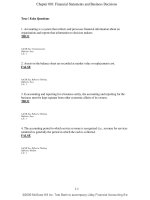Managerial accounting 6e jams jambalvo chapter 09
Bạn đang xem bản rút gọn của tài liệu. Xem và tải ngay bản đầy đủ của tài liệu tại đây (1.81 MB, 53 trang )
CHAPTER
CHAPTER 99
Capital Budgeting and
Other Long-Run Decisions
Slide 9-2
Capital
Capital Budgeting
Budgeting Decisions
Decisions
Companies, like individuals, make investments in long-lived assets
Examples include
Slide 9-3
Duke Energy invests in 400 roof-top solar panel installations
Pfizer invests in a $294 million biotechnology factory in Ireland
Nordstrom invests in a new store in New Jersey
Starbucks invests in a new product: instant coffee
Capital
Capital Budgeting
Budgeting Decisions
Decisions
Investment decisions are important because they have a long run impact
on a firm’s operations
Decisions involving the acquisition of long-lived assets are referred to as
capital expenditure decisions
They often require that capital (company funds) be expended to acquire
additional resources
Also called capital budgeting decisions
Learning objective 1: Define capital expenditure decisions and capital budgets and evaluate investment opportunities
Slide 9-4
using the net present value approach and the internal rate of return approach.
Capital
Capital Budgeting
Budgeting Decisions
Decisions
Most firms carefully analyze the potential projects in which they may
invest
The process of evaluating the investment opportunities is referred to as
capital budgeting
The final list of approved projects is referred to as the capital budget
Learning objective 1: Define capital expenditure decisions and capital budgets and evaluate investment opportunities
Slide 9-5
using the net present value approach and the internal rate of return approach.
Test Your Knowledge 1
Which of the following is not a capital expenditure decision?
a.
b.
c.
d.
Building a new factory
Purchasing a new piece of equipment
Purchasing inventory
Purchasing another company
Answer: c
Purchasing inventory
Learning objective 1: Define capital expenditure decisions and capital budgets and evaluate investment opportunities
Slide 9-6
using the net present value approach and the internal rate of return approach.
The
The Time
Time Value
Value of
of Money
Money
In evaluating an investment opportunity, a company must not only know
how much but also when cash is received or paid
Time value of money recognizes that it is better to receive a dollar today
than in the future
This is because a dollar received today can be invested so that it amounts
to more than a dollar in the future
Learning objective 1: Define capital expenditure decisions and capital budgets and evaluate investment opportunities
Slide 9-7
using the net present value approach and the internal rate of return approach.
Evaluating
Evaluating Opportunities:
Opportunities: Time
Time Value
Value of
of Money
Money Approaches
Approaches
Companies invest money today hoping to receive more money in the
future
By how much must the future cash flows exceed the cost of the
investment?
Money in the future is not equivalent to money today
A company needs to convert future dollars into their equivalent current , or
present value
Learning objective 1: Define capital expenditure decisions and capital budgets and evaluate investment opportunities
Slide 9-8
using the net present value approach and the internal rate of return approach.
Basic
Basic Time
Time Value
Value of
of Money
Money Calculations
Calculations
to convert future value to present value
Formula
Where: P = Present value
F = Future amount
r = Required rate of return
n = Number of years
Learning objective 1: Define capital expenditure decisions and capital budgets and evaluate investment opportunities
Slide 9-9
using the net present value approach and the internal rate of return approach.
Basic
Basic Time
Time Value
Value of
of Money
Money Calculations
Calculations -- Example
Example
At an interest rate of 10%, how much is $121 received two years from now worth
today?
Learning objective 1: Define capital expenditure decisions and capital budgets and evaluate investment opportunities
Slide 9-10
using the net present value approach and the internal rate of return approach.
Present
Present Value
Value Tables
Tables
Managers can use present value tables to look up present value factors
Present value factors are simply calculations of
Turn to Table 1 in Appendix B of this chapter
To find the factor for r = 12% and n = 5
Go across the top of the table to a discount rate of 12 percent and down five
rows
Learning objective 1: Define capital expenditure decisions and capital budgets and evaluate investment opportunities
Slide 9-11
using the net present value approach and the internal rate of return approach.
Test Your Knowledge 2
Using
the formula on slide 9-10, what is the present value of $500 received two
years in the future if you desire a return of 10%?
a.
b.
c.
d.
$413.22
$468.58
$471.60
$480.30
Answer: a
Learning objective 1: Define capital expenditure decisions and capital budgets and evaluate investment opportunities
Slide 9-12
using the net present value approach and the internal rate of return approach.
The
The Net
Net Present
Present Value
Value Method
Method
The only relevant cash flows are those that are incremental
The cash flows that will be incurred if the project is undertaken
Cash flows that have already been incurred are sunk
They have no bearing on a current investment decision
Learning objective 1: Define capital expenditure decisions and capital budgets and evaluate investment opportunities
Slide 9-13
using the net present value approach and the internal rate of return approach.
The
The Net
Net Present
Present Value
Value Method
Method
Steps in the NPV method
1.
Identify the amount and time period of each cash flow associated with a
potential investment
2. Discount the cash flows to their present values using a required rate of
return
3.
Evaluate the net present value, which is the sum of the present value of
all cash inflows and outflows
Learning objective 1: Define capital expenditure decisions and capital budgets and evaluate investment opportunities
Slide 9-14
using the net present value approach and the internal rate of return approach.
The
The Net
Net Present
Present Value
Value Method
Method
Evaluate the investment opportunity
If the NPV is zero, the investment earns the required rate of return
The investment should be undertaken
If the NPV is positive
It should also be undertaken because it earns more than the required
rate
Investments that have a negative NPV are not accepted because they
earn less than the required rate
Learning objective 1: Define capital expenditure decisions and capital budgets and evaluate investment opportunities
Slide 9-15
using the net present value approach and the internal rate of return approach.
Net
Net Present
Present Value
Value Approach
Approach
Learning objective 1: Define capital expenditure decisions and capital budgets and evaluate investment opportunities
Slide 9-16
using the net present value approach and the internal rate of return approach.
Test Your Knowledge 3
If the net present value of a project is zero, the project is earning a return
equal to:
a.
b.
c.
d.
Zero
The rate of inflation
The accounting rate of return
The required rate of return
Answer: d
The required rate of return
Learning objective 1: Define capital expenditure decisions and capital budgets and evaluate investment opportunities
Slide 9-17
using the net present value approach and the internal rate of return approach.
Net
Net Present
Present Value
Value Example
Example
An auto repair shop is considering the purchase of an automated paint spraying
machine. The machine will last five years.
Following information is available:
Each year $2,000 will be saved on paint
It will reduce labor costs by $20,000 each year
It will require maintenance costs of $1,000 each year
The machine costs $70,000
The expected residual value is $5,000
The required rate of return is 12%
Learning objective 1: Define capital expenditure decisions and capital budgets and evaluate investment opportunities
Slide 9-18
using the net present value approach and the internal rate of return approach.
Net
Net Present
Present Value
Value Example
Example
Since the NPV > 0, the company should buy the equipment
Learning objective 1: Define capital expenditure decisions and capital budgets and evaluate investment opportunities
Slide 9-19
using the net present value approach and the internal rate of return approach.
Comparing
Comparing Alternatives
Alternatives with
with NPV
NPV
Calculate the NPV of each alternative and choose the alternative with
the highest NPV
The difference between the NPVs of any two alternatives is the
incremental value of the highest NPV investment
Another method to evaluate alternatives is to compute the present
value of their incremental cash flows
Learning objective 1: Define capital expenditure decisions and capital budgets and evaluate investment opportunities
Slide 9-20
using the net present value approach and the internal rate of return approach.
Comparing
Comparing Alternatives
Alternatives with
with NPV
NPV
Learning objective 1: Define capital expenditure decisions and capital budgets and evaluate investment opportunities
Slide 9-21
using the net present value approach and the internal rate of return approach.
The
The Internal
Internal Rate
Rate of
of Return
Return (IRR)
(IRR) Method
Method
The internal rate of return is that rate of return that equates the present value
of the future cash flows to the investment outlay
The rate of return that makes the net present value equal to zero
If the IRR of a potential investment is equal to or greater than the required
rate of return, the investment should be undertaken
Learning objective 1: Define capital expenditure decisions and capital budgets and evaluate investment opportunities
Slide 9-22
using the net present value approach and the internal rate of return approach.
The
The Internal
Internal Rate
Rate of
of Return
Return Method
Method
Learning objective 1: Define capital expenditure decisions and capital budgets and evaluate investment opportunities
Slide 9-23
using the net present value approach and the internal rate of return approach.
Test Your Knowledge 4
An investment should be undertaken if:
a.
b.
c.
d.
The IRR is equal to or greater than the required rate of return
The IRR is equal to or greater than zero
The IRR is greater than the accounting rate of return
The IRR is greater than the present value factor
Answer: a
The IRR is equal to or greater than the required rate of return
Learning objective 1: Define capital expenditure decisions and capital budgets and evaluate investment opportunities
Slide 9-24
using the net present value approach and the internal rate of return approach.
The
The Internal
Internal Rate
Rate of
of Return
Return with
with Equal
Equal Cash
Cash Flows
Flows
Equal cash flows are called an annuity
For an annuity,
PV = PV factor x Annuity
Therefore:
Use the table to find the closest PV factor for the same number of
years
Learning objective 1: Define capital expenditure decisions and capital budgets and evaluate investment opportunities
Slide 9-25
using the net present value approach and the internal rate of return approach.









